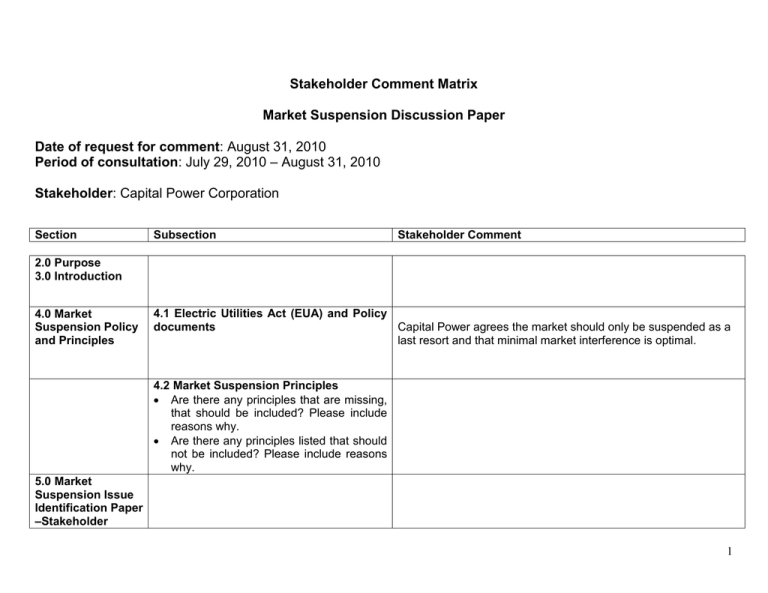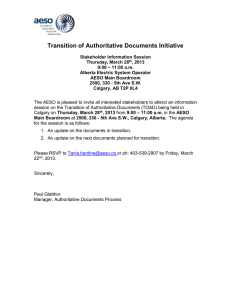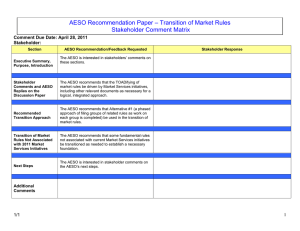Stakeholder Comment Matrix Market Suspension Discussion Paper Date of request for comment
advertisement

Stakeholder Comment Matrix Market Suspension Discussion Paper Date of request for comment: August 31, 2010 Period of consultation: July 29, 2010 – August 31, 2010 Stakeholder: Capital Power Corporation Section Subsection Stakeholder Comment 2.0 Purpose 3.0 Introduction 4.0 Market Suspension Policy and Principles 4.1 Electric Utilities Act (EUA) and Policy documents Capital Power agrees the market should only be suspended as a last resort and that minimal market interference is optimal. 4.2 Market Suspension Principles Are there any principles that are missing, that should be included? Please include reasons why. Are there any principles listed that should not be included? Please include reasons why. 5.0 Market Suspension Issue Identification Paper –Stakeholder 1 comments 6.0 Authority to suspend the market 6.1 Authority of the AUC within the rule Do you agree or disagree with the AESO’s proposal to remove the authority of the AUC to suspend market operations from the rule language? Please include reasons why. 6.2 Authority of the System Controller to suspend market operation Do you agree or disagree with the AESO’s assessment within this section? Please include reasons why. Agreed. Section 8 of the Alberta Utilities Commission (AUC) Act outlines the Power’s of the AUC. This does not need to be repeated in the rule language. Capital Power supports changes to the rule language that a market suspension requires the authorization of the Chief Executive Officer (CEO) of the AESO or his designee. Could the AESO confirm that the only other conditions that may result in a market suspension are, a) the AIES breaks up into two more electrical islands or b) the AEIS is not in a secure operating state? Could the AESO also confirm that provisions 6.9.2 e) and f) will be removed from the rule? 7.0 Options for consideration during the loss of market management tools 7.1 Limited Market Operation – market management tool outages Are there any points that the AESO has not considered in it’s assessment in Table 1? In the event of an outage of one or more market management tools, provided that there is access to a merit order, the AESO should move to limited market operations rather than suspending all markets. Capital Power understands that the Market Management Tools include: ETS (Energy Trading System), DT (Dispatch Tool), EMS (Energy Management System) and ADaMS (Automated Dispatch and Messaging System). Which tools are required to receive offer and restatement information from market participants and which tools are required to produce a current merit order. Could the AESO confirm that in the event that the SC is able to maintain a current merit order that it will be used to issue dispatches? 2 8.0 Pricing during an energy market suspension 7.2 Suspend all markets Are there any points that the AESO has Could the AESO clarify if it is planning to move to limited market not considered in it’s assessment in Table operations or to suspend all markets for conditions other than the loss of a Market Management Tool Outages such as; blackout, 1? breakup of the AIES into two or more electrical islands, the AIES not in a secure operating state or the system controller is forced to abandon the workplace? Which energy market suspension pricing option proposed in sections 8.1-8.6 does An administrative pricing mechanism should produce prices that your company support? Are there any reflect the current market fundamentals, such as the current levels other options that should be considered? of supply and demand, as accurately as possible and should ensure that market participants are not operating at a loss during a market suspension 8.1 Similar day demand patterns Are there any points that the AESO has not considered in it’s assessment on this option in Table 2? 8.2 30 Day Rolling Average Are there any points that the AESO not considered in it’s assessment on option in Table 2? 8.3 Reference Price Are there any points that the AESO not considered in it’s assessment on option in Table 2? This option only considers the level of demand and does not control for the level of supply. We agree that demand levels and subsequent prices during normal operations may not be the appropriate benchmark for the system conditions that result in a market suspension. has The 30 Day Rolling Average option considers only historical prices this rather than current market fundamentals. has A reference price that uses a fixed HR may result in dispatched this assets not being able to fully recover their costs. The monthly gas price is not appropriate as it does not reflect changes to the current market fundaments. 8.4 Status Quo Are there any points that the AESO has This option does not produce a price that reflects the current 3 not considered in it’s assessment on option in Table 2? 8.5 Same day of the week Are there any points that the AESO not considered in it’s assessment on option in Table 2? 8.6 Combined approach Are there any points that the AESO not considered in it’s assessment on option in Table 2? this market fundamentals or ensure that dispatched assets are able to recover their costs. has This option does not accurately reflect the current market this fundamentals and will therefore not send the appropriate price signals. has Capital Power agrees that when all available MW’s are dispatched this that price should be set at the cap. In blackout situations, we would argue that a high price is unnecessary. The clear priority during such events is to reenergize the system as quickly as possible. Although we support the combined approach we do not support any of the proposed options (8.1 through 8.5) for the reasons discussed above. It is our view that the AESO should adopt the combined approach but in instances where price is not set at the cap, price should be set using the last available merit order. That is, the price should be set by the dispatched unit with the highest offer in the last available merit order. This is not only consistent with moving to limited market operations for a loss of a market management tool but using the last available merit order produces a more efficient market signal than any of the options described in sections 8.1 to 8.5 as the price changes to reflect changes to both supply (MW’s dispatched) and demand. It is also consistent with setting price at the cap when available MW’s are dispatched. The AESO indicated that the main disadvantage of the using the last available merit order is that changes in offers would not be incorporated and the system controller would not be using the most up to date information. Although the information is not as current as is typically available, it is still far more current than the information reflected using any of the options described in Section 8.1 through 8.5. 4 Therefore, we support the combined approach with limited market operations. 9.0 Market Suspension for reliability issues 10.0 Market Suspension for market issues 11.0 Importing during a market suspension Capital Power agrees with the AESO assessment that rules are not required for non-competitive outcomes that may result should there be an AIES system failure as there are other mechanisms/agencies in place (i.e. MSA) to address these types of concerns. Are the existing mechanisms under OPP 807 and OPP 803 sufficient during a In the event that a market suspension is declared and the AESO is unable to accept restatements or offers from inter-Alberta market suspension? generators it should not accept offers from importers or exporters. If imports are required to avoid shedding load or to maintain sufficient Ancillary Services OPP 803 and 807 should be followed to request emergency power. However, the system controller should not request emergency power for any other reason. 12.0 Next steps Additional Comments 5


